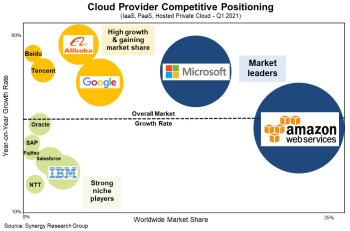 You get a cloud. And you get a cloud. Everybody gets a cloud.
You get a cloud. And you get a cloud. Everybody gets a cloud.
Well, most people.
Several years ago, the idea of the “hybrid cloud” died. The idea that companies should keep their data centers while moving “customer facing” applications only to the public cloud didn’t make economic sense. Cloud applications ran so much cheaper than systems designed for mainframes or internal networks.
It wasn’t just about hardware. It was also about software. Proprietary software couldn’t compete with open source. Linux won. Even Microsoft admitted it. Tech companies acted rationally, by extracting the equivalent of “monopoly rents” from their data center offerings, which hastened the move to public cloud.
Now things may be about to reverse. That’s because, as companies and organizations have gone “all-in” on cloud, they’re finding themselves with huge bills. If Google or Microsoft or Amazon is the “one throat you can choke,” they’re the ones choking you.
 With cloud bills out of control, companies are now looking to re-engineer what they have toward cloud standards, and to rebuild their data centers using cloud standards. This gives them the open source and software savings of cloud. It also gives them a counterweight to public cloud spend.
With cloud bills out of control, companies are now looking to re-engineer what they have toward cloud standards, and to rebuild their data centers using cloud standards. This gives them the open source and software savings of cloud. It also gives them a counterweight to public cloud spend.
You can see the first stirrings of this at Synergy Research, my go-to source for public cloud research. It’s at the bottom left of this chart, where the database application folks like Oracle, SAP, IBM, and Salesforce.Com are building out clouds to keep their customers.
The next step will be for their customers to seek to hyperscale their own data centers to reduce their cloud spend. This could initially benefit outfits like Digital Realty, Equinix, and Blackstone’s QTS, which can host the new clouds. But as big companies scale operations, watch for them to roll their own again. The winners here will be Dell and IBM, which were losers in the first hybrid cloud fight, but which have re-engineered themselves around VMware and Red Hat.
The point is there is no “final form” for computing, there’s only continuous evolution. As more companies own their own data centers, then, expect more computer capacity to move toward the network edge and the Machine Internet. They’ll be plenty of competition for it, as Google, Microsoft and Amazon realize their current public cloud “monopoly” has a limited life span.
That’s why antitrust authorities need to be careful. Why fight Amazon when the market will do it for you?









